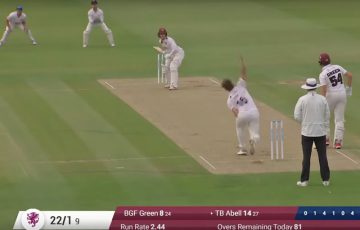We were in Bristol to see England play Sri Lanka yesterday. Without wishing to saunter too far into match report territory, we and our companions finished the day by setting a strict departure time when we would cease standing around in the rain and would instead head home.
It wasn’t that we thought there was still some outside chance of play. It was more that this is the traditional way of going about things when a match is being rained off. You make a deadline and you stick to it in defiance of reason. Watching cricket on a rainy day is very much about summoning optimism in the face of facts and to stand there in the rain, knowing the match was finished, seemed the purest example of this spirit.
We knew the match had finished not because it had been officially announced, but because, like everyone in the crowd, we had access to all manner of weather apps and rainfall radars and the like. If truth be known, long before their arrival at the ground, pretty much everyone in the crowd knew that the players would depart mid-afternoon, never to be seen again.
The match was viewed in that knowledge. Most people knew they were there to see a one innings game; that all that was taking place before them was in all likelihood meaningless. This seems an odd situation.
When a one-day match is hit by rain, it is shortened. However, matches are never shortened in anticipation of rain. Is this right?
The danger of shortening a match for rain-that-is-yet-to-come is of course that said rain might never fall, leading to the bizarre spectacle of the match ending prematurely in bright sunshine. This does however seem to us a more acceptable outcome than the going-through-the-motions half game we witnessed yesterday.
Perhaps the umpires – or better yet, some well-informed locals – could be entrusted to make a call on shortening a match based on the likelihood of impending rain. There are days of scattered showers and there are days where a wall of water is slowly looming into view from the west and it’s just a matter of time. In the latter case, a halving of the overs would seem sensible.
And if informed people in positions of power are unwilling to take such a decision, they could always absolve themselves of responsibility by putting it to a public vote.



I have a suggestion. First play a between the two teams. Then a T20 match between the two teams. Then play the remaining 29 overs each between the two teams. I hope this will be an acceptable compromise.
First play a *super-over*
(my typing skills on mobile are becoming very horrible :(( )
How would D/L / DLS cope with a scenario whereby this mini-super-series were itself weather-interrupted?
Let me modify the proposal slightly then:
ICC/DLS require a minimum of 20 overs for the chasing team. Assuming this is sufficient for team batting 1st also then we can derive a solution as follows:-
1a) when there is a possibility of rain, then the team that bats 1st has to interrupt their innings after 20 overs
1b) bases on 20 over score of team batting 1st, a DLS projected score for entire 50 overs is calculated and is set as nominal target for the “chasing” team
2a) the “chasing” team now has to bat at least 20 overs.
2b) After that they can continue till they overhaul the “nominal” projected target or stop anytime in between or bat all 50 overs if they never reached the nominal target
3a) now the 1st batting team returns for their 2nd & final innings and bat until they can complete their entire quota of overs or they managed to overhaul the 50 over (or DLS target in case of shortened match)
4a) if the combined score of 1st batting team is more than “chasing” team’s total and the chasing team has overs still left in their quota they then resume batting and bat until the match is over.
Above suggestion, I think should be compatible with all DLS rules and if satisfactory, then this format can be used for all ODIs irrespective of the possibility of rain. This will have added benefit of helping teams neutralise conditions such as a wet wicket or dew under lights etc
Cheers.
Could you explain your proposal to Aunt Agatha, Marees?
Thought not.
As for putting the matter to a public vote, KC, we all know how Aunt Agatha tends to vote. Leave it out.
Ged, I can understand that this method is complicated, but if the game & fans have come to accept DRS & DLS, then they can certainly take this change also in their stride, I hope.
I was also there (I managed to get sunburn and also get rained on quite a lot, which pretty much summed up the day), and had a similar conversation, particularly as one of my match-going companions had also been in attendance at Old Trafford a few years back when he and I saw 22ish overs in an England – Australia T20, with 20 of them being the Australian innings.
The rain was actually fairly persistent throughout the Sri Lankan innings, from what I remember there was only about half an hour of sunshine all day (which must have been the time my sunburn was originated).
Yes, we must commend you on attaining sunburn. We felt in little danger of this even during the short period early on during which some of our skin was visible.
Can’t help thinking this will become standard practice in the next decade. Given previous experience of ICC rollouts then it will either be implemented without proper testing in less important matches, or not implemented until we’ve all given up hope that it will ever happen.